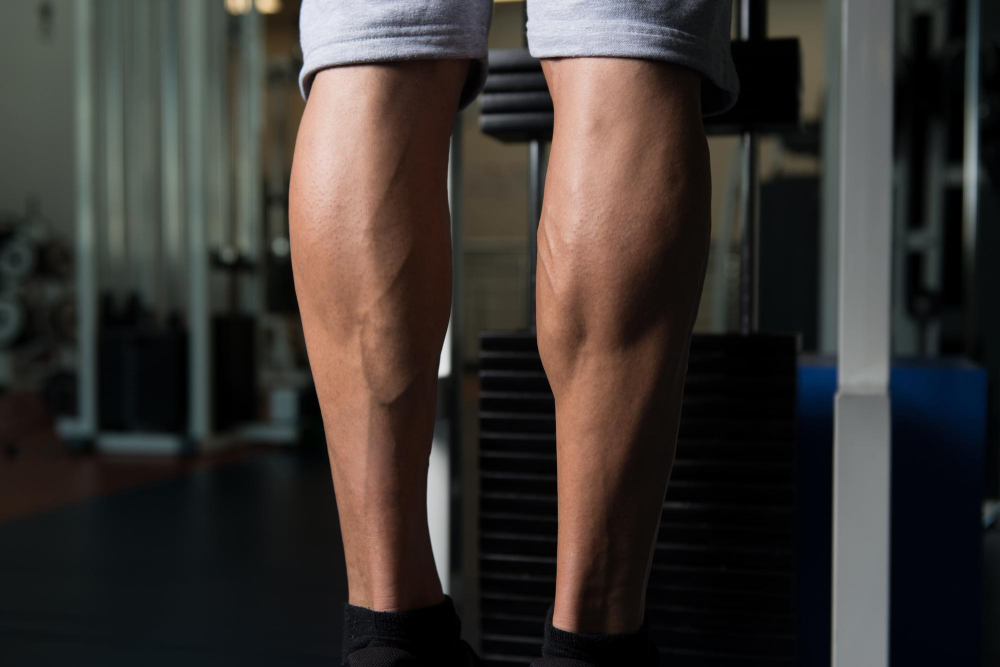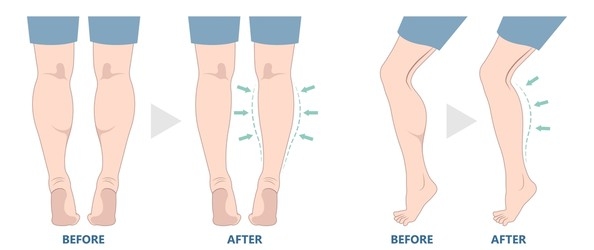Calf Implants
Calf implants are used to improve the appearance of one’s lower legs. Many individuals opt for calf implants as a form of cosmetic surgery, aiming to enhance the shape and attractiveness of their legs. Additionally, bodybuilders may choose to undergo calf implant surgery in order to achieve a more muscular appearance. In specific cases, calf implants may be necessary for individuals undergoing reconstructive or gender affirmation surgery. The procedure for calf implants is carried out by a plastic surgeon.

Why do people get calf implants?
- Absence of clarity: Certain individuals possess naturally slender or underdeveloped calf muscles, resulting in an absence of distinctiveness in the lower leg. The implementation of calf implants can grant the illusion of a greater definition and strength in the calf muscles.
- Injuries or congenital abnormalities can lead to unevenness or deformities in the calf region. The use of calf implants can assist in restoring balance, enhancing the aesthetic appeal of the impacted leg.
- Body dissatisfaction is a common issue where individuals feel unhappy with the look of their legs, believing that they are either too skinny or too petite. To enhance the aesthetics and achieve a more pleasing look, people may opt for calf implant surgery, which aims to enlarge the size and volume of the calf muscles.
- Enhanced self-assurance: Self-esteem and confidence can be greatly influenced by the appearance of one’s legs. Calf implant surgery offers a solution to boost self-confidence by enhancing the attractiveness and pleasing look of the legs.
Who qualifies as a candidate for calf implant surgery?
An individual who is suitable for calf implants would be someone who:
- Is engaged in physical activity and weightlifting to develop the muscles in the lower part of the leg.
- Possesses a fully developed musculoskeletal system in adulthood.
- Is not a smoker or is able to quit smoking prior to the procedure (since nicotine increases the chances of surgical complications and slows down the healing process).
- Understands the likely results of calf implant surgery without unrealistic expectations.
Things to consider once you’ve decided to have calf implants
Once you have made the decision to proceed with calf implants and have selected a skilled surgeon for the procedure, the important choices you will need to make include selecting the right type and size of implant, as well as deciding on the brand of implant. Your surgeon will provide guidance and assistance throughout this decision-making process.

Size and shape of implants
Calf implants come in a range of lengths, widths, and thicknesses, and can also have different shapes. However, unlike breast implants, it’s not easy to imagine how different sizes and shapes of calf implants will appear once they are inserted into the leg. To get a better idea, some people find it helpful to try placing the implants on the sides of the calf and wearing stockings over them to assess potential improvements. Your surgeon will assist you in making this decision.
In cosmetic procedures for enhancing calf muscles, it is necessary to use two implants in order to replicate the natural structure of the calf muscle, which consists of two distinct areas. Using a single, larger implant can result in an irregular shape to the leg, which appears artificial.
The size of implants selected can have an effect on the pain and discomfort experienced after the implant is inserted, as well as how long the implants will last. Opting for implants that are too large for your legs can lead to problems caused by excessive pressure. Pain, muscle issues, and nerve compression are frequent concerns associated with extremely large implants. More information about potential risks and complications is provided in the section addressing these matters.
For calf implants, it is recommended to begin with a smaller size initially and then, if needed, switch to a larger size.
Type of implants
There are various types of calf implants available, all made from soft solid silicone. Some surgeons prefer to use contoured implant-grade silicone carving blocks made from soft-solid silicone elastomer. These blocks can be customized to fit your specific measurements and provide surgeons with more flexibility and precision during the procedure. They come in different sizes and shapes to make the process of fine-tuning easier. Alternatively, you can choose to use pre-made pliable and sculptable silicone calf implants, similar to breast implants, which do not require any trimming. Ultimately, the choice is up to you, but your surgeon will be able to recommend the best option based on their personal preferences and past experience.
Calf implants are resistant to rupture or damage during physical activities like contact sports due to their lack of liquid or gel content.
Brand of implants
The surgeon will recommend the suitable implant for you, and currently, there is one choice available in Australia. It is an Allied Biomedical implant, belonging to Implantech. This company has a history of manufacturing implants with a remarkable reputation over the years.
How Does Calf Augmentation Work?

Two different surgical methods are employed for calf implants: submuscular and subfascial calf augmentation procedures. Submuscular augmentation entails making a space within the fibrous tissue sheets located beneath the main calf muscles. On the other hand, the subfascial augmentation procedure involves creating a pocket between the muscle and the underlying skin fascia.
By employing these methods, the implants are shielded by tissue located beneath the skin or muscle fibers, leading to an outcome that is both comfortable and visually appealing, while also appearing natural.
The process starts by making a cut on the skin at the back of the knee and creating a space in the calf tissue. Next, the surgeon will carefully place the implant in the created space. Finally, the incisions will be sealed using stitches or adhesive and bandages will be placed on top.
Calf implant placement options
- One implant in one leg
- Two implants in one leg
- One implant in each leg
- Two implants in both legs
Calf implants enable a better balance between your body and the size of your knees and ankles. Since calves are prominently visible, enhancing them through this procedure can greatly enhance patients’ self-confidence and self-worth.
How Long is the Calf Augmentation Recovery?
The recovery time for calf augmentation surgery typically ranges from 2 to 8 weeks. During the initial two weeks after the procedure, it is important to keep your legs elevated for optimal healing. This may require assistance when standing up to use the restroom. It is advised to gradually increase your activity level by walking around the house, although you may experience stiffness during this period.
In a few weeks after the operation, you can anticipate resuming your normal walking routine. The bruising will lessen, the healing process of your scar will start, and you should be able to engage in regular activities after 8 weeks. Until then, refrain from rigorous leg activities like running, cycling, or lifting heavy weights using your legs.
The speed at which you heal has a significant impact on your recovery and can vary greatly among individuals, therefore these are only broad recommendations.
Having Calf Implants Surgery in Turkey?
The patient must carefully search for an appropriate service provider, have information, and ask about the surgeon and his experience. And also, checking examples of his previous operations.
Accordingly, we encourage you to contact the Health & Beauty to obtain all information and details, and to ensure that you have your operation done by the hands of the most skilled doctors working in this specialty.
